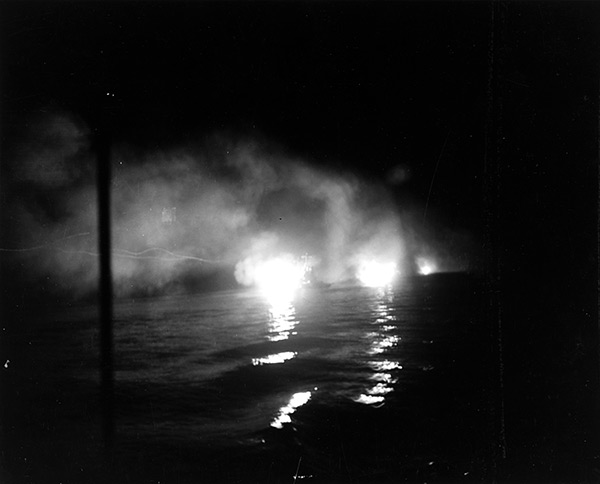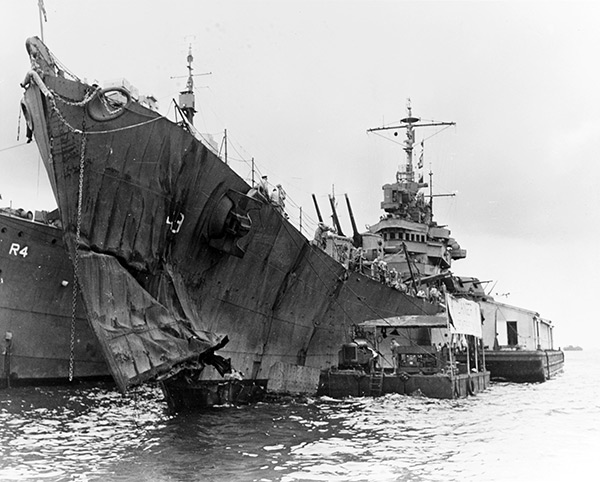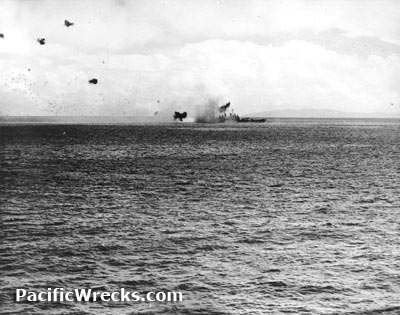|
|
|
| Missing In Action (MIA) | Prisoners Of War (POW) | Unexploded Ordnance (UXO) |
| Chronology | Locations | Aircraft | Ships | Submit Info | How You Can Help | Donate |
|
| USN St. Louis Class Light Cruiser 10,000 Tons 608.3' x 61.7' x 19.8' 15 x 6"/47 cal guns 8 x 5"/38 cal guns 16 x 1.1/75 cal AA guns 12 x 20mm AA guns 1 x depth charge rack  USN July 6, 1943  USN July 13, 1943   USN November 27, 1944 |
Ship History Built by Newport News Shipbuilding and Dry Dock Company in Newport News, Virginia. Laid down December 10, 1936. Launched April 15, 1938 sponsored by Miss Nancy Lee Morrill. Commissioned May 19, 1939 with Captain Charles H. Morrison in command. At Norfolk, underwent fitting out and completed her shakedown cruise on October 6, 1939. Over the next eleven months, commenced neutrality patrol operations across the West Indies to the North Atlantic. Departed September 3, 1940 with an inspection board to evaluate naval and air bases from Newfoundland to British Guiana, that the US Navy gained access in exchange for lend lease to the British then returned to Norfolk on October 27. On November 9, departed for the Pacific, transiting the Panama Canal on November 14 then proceeded to Pearl Harbor arriving December 12. Participated in fleet maneuvers and conducted patrols during the winter of 1940 and 1941 then to Mare Island for overhaul then returned to Pearl Harbor on June 20. Two months later, she sailed west with other cruisers of the Battle Force; patrolled between Wake, Midway, and Guam; then, proceeded to Manila, whence she returned to Hawaii at the end of September. On September 28, returned to Pearl Harbor for maintenance. Pearl Harbor Attack On December 7, 1941 moored to the pier at Southeast Loch inside Pearl Harbor. At 7:56am Japanese planes were spotted by observers aboard St. Louis. Within minutes, the ship was at general quarters and her operable anti-aircraft guns were manned and opened fire. By 8:06am, preparations for getting underway had begun. At about 08:20, one of the cruiser's gun crews shot down its first enemy torpedo plane. By 09:00, two more enemy aircraft had joined the first. At 09:31, St. Louis moved away from the pier and headed for South Channel and the open sea. Fifteen minutes later, her 6 inch guns, whose power leads had been disconnected, were in full operating order. As the cruiser moved into the channel entrance, she became the target of a midget submarine. The enemy's torpedoes, however, exploded on striking a shoal less than 200 yards from the ship. Destroyers then pounded the bottom with depth charges and St. Louis continued out to sea where she joined in the search for the Japanese fleet. After failing to locate the enemy strike force, the hunters returned to Pearl Harbor on 10 December, and St. Louis turned to escorting transports carrying casualties to San Francisco and troops to Hawaii. Wartime History On January 6, 1942 departs San Francisco with Task Force 17 (TF 17) centered around USS Yorktown and escorted transports with the Marine Expeditionary Force to Samoa to reinforce defenses. Between January 20-24, 1942 covered the group offloading at Pago Pago; then moved to conduct air strikes in the Marshalls and the Gilberts before returning to Pearl Harbor on February 7, 1942. Upon her return to Pearl Harbor, St. Louis resumed escort duty with Hawaii–California convoys. In the spring, after a trip to the New Hebrides, escorted SS President Coolidge, which was carrying President Quezon of the Philippines to the west coast, arriving at San Francisco on 8 May. The following day, she was again bound for Pearl Harbor. There, she switched to a reinforcement group carrying Marine aircraft and personnel to Midway in anticipation of Japanese efforts to take that key outpost. On the 25th, she delivered her charges to their mid-ocean destination; then moved north as a unit of TP 8 to reinforce Aleutian defenses. On 31 May, St. Louis arrived at Kodiak; refueled; and got underway to patrol south of the Alaskan Peninsula. Through July, she continued the patrols, ranging westward to intercept enemy shipping. On 3 August 3, 1942 she departed for for Kiska Island to participate in her first shore bombardment mission. On August 7, 1942 Rear Admiral William W. Smith's Task Group 8.6 (TG 8.6) bombardment group shells Kiska Island including USS Louisville (CA-28), USS Indianapolis (CA-35), USS Nashville (CL-43), USS Honolulu (CL-48) and USS St. Louis (CL-49) plus destroyers USS Elliot (DD-146), USS Reid (DD-369), USS Case (DD-370), USS Gridley (DD-380) and USS McCall (DD-400). Although fog limited observation their floatplanes reported ships sinking in Kiska Harbor and fires burning among shore installations. The Japanese were caught by surprise and took fifteen minutes before shore batteries returned fire and Japanese seaplanes made ineffective attacks. The operation was considered a success despite the scanty information on its results. After the mission, the cruiser returns to Kodiak on August 11, 1942 and continued patrols in the Aleutian area and covered the Allied landing on Adak Island. On October 25, 1942 proceeded via Dutch Harbor to Mare Island for overhaul. On 4 December, she departed San Francisco with transports bound for New Caledonia. She shepherded the convoy to Noumea on the 21st, then shifted to Espiritu Santo whence she proceeded into the Solomons. She commenced operations there in January 1943 with bombardments of Japanese air facilities at Munda and Kolombangara; and, during the next five months, repeated those raids and patrolled the “Slot” in the Central Solomons in an effort to halt the “Tokyo Express” reinforcement and supply shipping that sought, almost nightly, to bolster Japanese garrisons. Shortly after midnight on 4 July–5 July, she participated in the bombardment of Vila and Bairoko Harbor, New Georgia. Her division, Cruiser Division 9 and its screen, Destroyer Squadron 21 (DesRon 21) then retired back toward Tulagi to replenish as troops were landed at Rice Anchorage. Battle of Kolombangara On July 6, 1943 in the early morning, the cruiser-destroyer force located and engaged ten enemy destroyers with reinforcements bound for Vila on Kolombangara. During the Battle of Kula Gulf sunk by torpedoes was USS Helena (CL-50) for the loss of two Japanese destroyers sunk. Battle of Kolombangara On July 12, 1943 the same force, Task Force 18 (TF 18) reinforced by DesRon 12, moved from Tulagi up the “Slot” northward. On July 13, 1943 after 1:00am during the Battle of Kolombangara (Second Battle of Kula Gulf) engaged an enemy force including Jintsu and five destroyers. During the battle, which raged for over an hour, the Japanese cruiser Jintsu and USS Gwin were sunk and the light cruisers HMNZS Leander, Honolulu, and St. Louis were damaged. St. Louis took a torpedo which hit well forward and twisted her bow, but caused no serious casualties. She returned to Tulagi on the afternoon of the 13th. From there, she moved on to Espiritu Santo for temporary repairs; then steamed east, to Mare Island, to complete the work. In mid-November, she returned to the Solomons and, from the 20th to the 25th, covered marines fighting for Bougainville. In December, she returned to that island to shell troop concentrations and, in January 1944, shifted southward to bombard enemy installations in the Shortlands. Thence, she moved back to Bougainville to cover the landing of reinforcements at Cape Torokina. On 10 January, she headed back to Florida Island. In February, she again moved northwest, this time into the extreme northern Solomons and the Bismarcks. On the 13th, she arrived in the area between Buka and St. George Channel to support landing operations in the Green Islands off New Ireland. At 18:55 on the 14th, six Vals were sighted approaching St. Louis's group. Crossing astern of the ships, the enemy planes went out to the southeast, turned, and returned. Only five remained in the formation which split into two groups. Two of the planes closed towards St. Louis. The first plane dropped three bombs, all near misses. The second released three more. One scored on the light cruiser; the other two were near misses just off the port quarter. The bomb which hit St. Louis penetrated the 40 millimeter clipping room near the number 6 mount and exploded in the midship living compartment. Twenty-three died and 20 were wounded, 10 seriously. A fire which had started in the clipping room was extinguished. Both of her planes were rendered inoperable; her ventilation system was damaged. Communication with the after engine room ceased, and the cruiser slowed to 18 knots. On the 15th, she survived another air attack and was then ordered back to Purvis Bay. Repairs were completed by the end of the month; and, in March, St. Louis resumed operations with her division. Through May, she remained in the Solomons. Then, on 4 June, she moved north to the Marshalls, whence, on the 10th, she sailed for the Marianas in TF 52, the Saipan assault force. Four days later, she cruised off southern Saipan. On the 15th, she shelled the Charan Kanoa area; retired as the landings took place; then moved back to provide call fire support and to shell targets of opportunity. On the 16th, she proceeded south and bombarded the Asan beach area of Guam. She then returned to Saipan and, on the 17th, shifted to an area north of that island where she remained through the battle of the Philippine Sea. On the 22nd, she returned to Saipan and, after screening the refueling group for two days, proceeded to the Marshalls. On 14 July, St. Louis again headed for the Marianas. The next day, she damaged her number 3 propeller and lost 39 feet of the tail shaft. Nevertheless, two days later, she arrived off Guam as scheduled; and, during the afternoon, covered underwater demolition teams working the proposed landing beaches. Preinvasion shore bombardment followed; and, after the landings on the 21st, she provided support fire and call fire. On the 29th, St. Louis departed the Marianas for Pearl Harbor, whence she was routed on to California for overhaul. In mid-October, she steamed back to Hawaii; trained until the end of the month; then moved on across the Pacific, via Ulithi and Kossol Roads, to the Philippines, arriving in Leyte Gulf on 16 November. Leyte Gulf During the next ten days, she patrolled Leyte Gulf and Surigao Strait using her anti-aircraft guns to protect shipping in the area. On November 27, 1944 shortly before noon a formation of 12-14 enemy aircraft attacked the cruiser formation including St. Louis and was unscathed during the brief air raid. A request was made for a friendly Combat Air Patrol (CAP) but none arrived to render aid. At 11:30am ten more enemy planes arrived and divided into three groups of four, four and two. At 11:38am a D3A Val hit and on fire made a kamikaze attack (suicide dive) and hit St. Louis on the port quarter and exploded on impact causing fires aboard the hanger area and nearby spaces and 20mm gun crews no. 7, no, 8, no. 9 and no. 10 were killed or wounded. At 11:39, a second enemy plane on fire aimed at the port beam of St. Louis and the cruiser attempted to reach flank speed and perform a hard right turn as the plane passed over the no. 4 turret and crashed into the sea only 100 yards away. Next, at 11:51am two more enemy planes both on fire attacked St. Louis. The first was shot down and crashed into the sea off the port quarter and the second dove in from starboard and crashed almost on board on the port side and tore off a 20' section of armor belt and caused holes in the hull. By 11:52, the damaged cruiser developed a list to port. At 12:10pm another Japanese suicde plane approached but was shot down 400 yards astern. At 12:20pm, enemy torpedo planes approached and released aerial torpedoes. St. Louis warned a nearby PT Boat that barely avoided one of the torpedoes and luckily none of them impacted. At 12:36pm St. Louis was back on an even keel. Within thirty minutes of the attacks, all major fires were extinguished and salvage work began. During all the day's attacks a total of 15 were killed, 1 missing, 21 seriously wounded and 22 sustained minor injuries. On November 28, 1944 the most seriously wounded were transferred off for medical attention. On November 30, 1944 entered San Pedro Bay where temporary repairs were made then departed via Seealder Harbor and was the first ship to enter USS ABSD-4 for repairs then crossed the Pacific bound for California. During late December 1944 arrived in California and underwent more repairs. On March 1, 1945 departed California across the Pacific to Ulithi and joined the fast carrier force. By the end of the month, she had participated in strikes against the southern Japan then moved south to the Ryukyus to join Task Force 54 (TF-54) and participated in shore bombardment of Okinawa Island and guarded minesweepers and underwater demolition teams clearing channels to the assault beaches. On March 31, 1944 entered Kerama Retto to replenish then returned to station off Okinawa Island to support the U.S. forces that landed on the Hagushi beaches April 1, 1945. Five days later, the cruiser covered minesweepers off Ie Jima, then resumed fire support and antiaircraft duties off Okinawa. On 18 May, she departed Hagushi for a brief respite at Leyte; and, in mid-June, she resumed support operations off Okinawa. On 25 July, she shifted to TF 95; and on the 28th, she supported air strikes against Japanese installations on the Asiatic mainland. Sweeps of the East China Sea followed; and, in early August, she anchored in Buckner Bay, where she remained through the end of hostilities on 15 August. Postwar duties kept the cruiser in the Far East for another two and one-half months. In late August, while in the Philippines, she was assigned to TF 73 as part of the patrol foce in the Yangtze River. During September, as other ships joined the force, she was at Buckner Bay and in October, she moved on to Shanghai. In mid-October, she helped to lift Chinese Army units to Formosa; then she joined the "Magic Carpet" fleet to carry veterans back to the United States. Awards For her World War II service, St. Louis earned eleven battle stars. Postwar St. Louis completed her first "Magic Carpet" run at San Francisco on 9 November; and by mid-January 1946, made two more runs, both to islands in the Central and Southwest Pacific. In early February, she sailed for the east coast and arrived at Philadelphia for inactivation on the 25th. She was decommissioned on 20 June and berthed at League Island with the 16th (Inactive) Fleet through the decade. Early in the 1950s, she was designated for transfer to the government of Brazil. On January 22, 1951 struck from the Navy list and designated for transfer to Brazil. On January 29, 1951 commissioned in the Brazilian Navy as Tamandare (C-12) named for Joaquim Marques Lisboa, Marquis of Tamandaré and served as the flagship of the fleet. Participated in the Lobster War (Lobster Operation). Decommissioned on June 28, 1976 and offered for sale then sold four years later. Sinking History During August 1980, towed from Rio de Janeiro eastward bound for Taiwan to be broken up for scrap metal. On August 24, 1980 while under tow to Taiwan sunk near the Cape of Good Hope off South Africa at roughly Lat 38° 48' S Long 1° 24' W. References Navy Source - USS St. Louis CL-49 (photos) Contribute
Information Last Updated
|
Photo Archive |
| Discussion Forum | Daily Updates | Reviews | Museums | Interviews & Oral Histories |
|